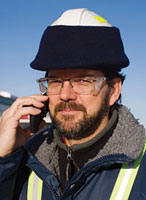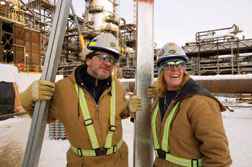...areas and workers follow a “buddy system” and watch each other for signs of frostbite. CNRL expects to produce its first oil on Aug. 5 but the project is already behind schedule. Workers go back to camp, without pay, where they hope the pipes don’t freeze; if they do, there’s nowhere to go. On Feb. 4, it’s warm enough to resume full operations. But CNRL later tells analysts that the expansion’s estimated $6.8-billion cost could climb by up to $1.9 billion, in large part because of productivity declines related to cold weather.
Despite the generous pay scale—a mechanic can make more than $100,000 per year with overtime—staffing has been a problem. Young Canadians are not filling the ranks of the trades and the median age on the job site is 50, says Dubord. The Canadian government recently relaxed visa restriction in 21 job categories, mostly to help the Alberta oil-sands producers gear up for expansion. At Horizon, PCL turned for help to Technip S.A., CNRL’s Rome-based engineer-procurement-construction contractor. The Italian firm helped PCL find elec-tricians and pipefitters from Portugal. There are also workers on site from South Africa, the U.K., India and the Philippines.
 Michael Goodman / ENR Dubord eyes progress
|
Process
There are two ways to squeeze energy from oil sands: strip-mining and steam injection. Both require vast amounts of energy and water.
Stripping 20 to 40 meters of overburden to uncover a similar thickness of bitumen is a job for the world’s biggest mining equipment. CNRL’s overburden removal contractor, Acheson, Alberta-based North American Construction Group, is already working. David Sheaves, a CNRL safety officer, points to a large shovel. “That bucket holds 43 cubic yards,” he says. Four scoops will fill a 400-ton heavy hauler.
Sheaves says the Horizon job is taking delivery of 24 new CAT 797Bs, each costing about $5 million. That’s without the tires, which are about 13 ft in diameter. Tires normally cost about $40,000, but a worldwide shortage has driven the cost up to $60,000. Drivers perched in cabs 20 ft high work 12-hour shifts. If they stop for more than three minutes to refuel, the dispatcher will call to ask what’s wrong.
Trucks deliver ore to the preparation plant, where it is crushed and mixed with hot water and diluent. Slurry is pumped to an extraction plant and flowed into separation chambers. Then, sand and water flow out the bottom and are diverted into huge tailings ponds.
Diluent is recovered from the separation chambers and recycled back into the process flow. Bitumen skimmed from the froth is transported to an upgrader. The final thermal stage treats the bitumen, separating it into fractions. Sweet, lighter synthetic oil is ready for transport to a refinery. Heavier fractions are cycled through a coker where sulphur and other impurities are removed. The sour product is ready for hydro treatment and pipeline transport to refineries in Edmonton, 435 miles away.
The other recovery method is steam-assisted gravity drainage, which uses two horizontal pipes drilled into the ore seam. The upper pipe injects steam and the lower collects the bitumen-rich condensate.
 Michael Goodman / ENR Rose Klatt is a laborer; husband Paul is a pipefitter. They spend their nights in camp.
|
For some Canadians, the mad dash to squeeze every available Btu from a sparsely populated patch of land roughly the size of Florida is a race to ecological disaster. The website www.tarsandswatch.org tabs the negatives: global warming, water depletion, aboriginal rights, social collapse, energy security and military links. In a report released Feb. 15, watchdog Environmental Defense called the oil sands the most destructive project on earth.
To Peter Stahlenhoef, president of PCL’s industrial unit, oil companies are the most demanding owners he’s ever encountered. PCL has worked for most over the years. With a mixture of candor and respect he describes the relationship: “They’re the biggest, meanest giants in the valley. They’re extremely smart, and they control costs to the penny. As for compliance, they’ll do what they’re compelled to, but nothing more.”
Should regulations pass requiring large-scale carbon sequestration, Stahlenhoef says, “We’re very confident that we would have a very large role to play there, as well”.

Post a comment to this article
Report Abusive Comment